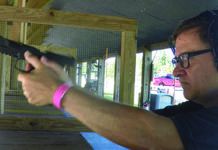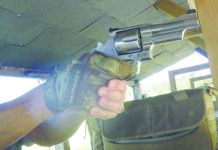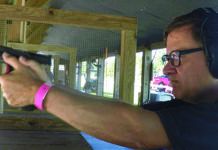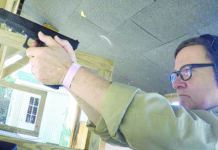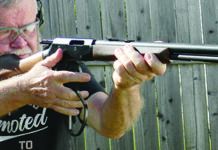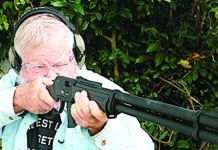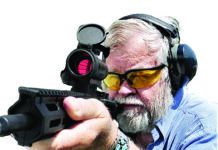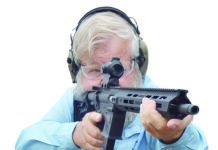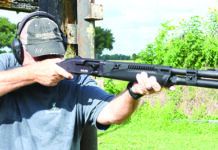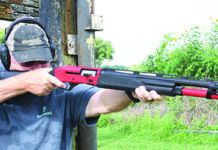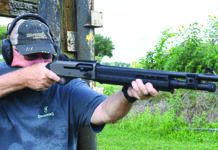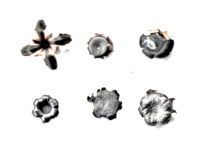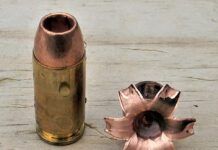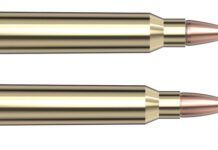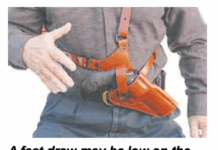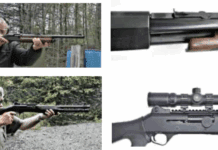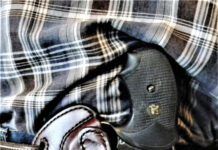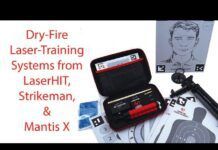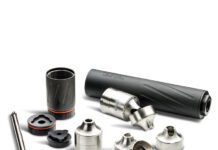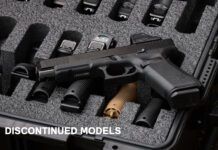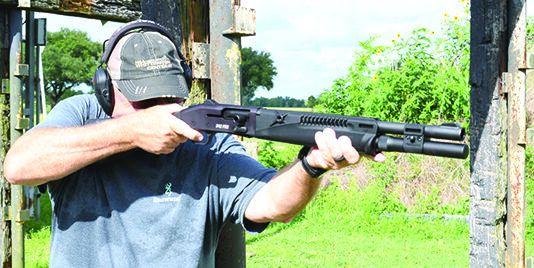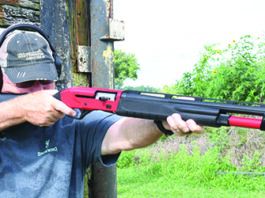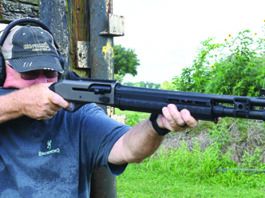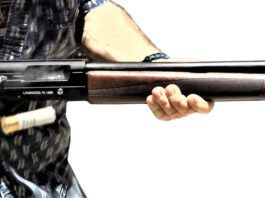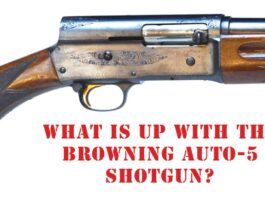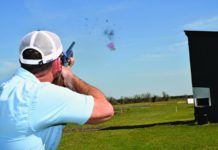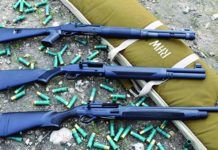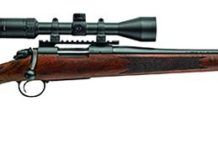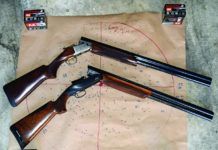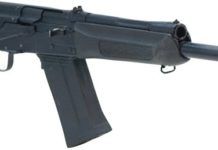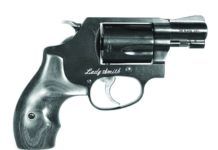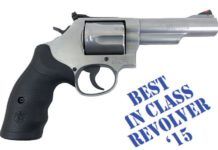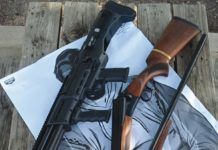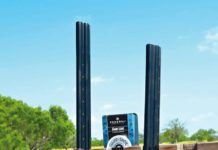28-Gauge Showdown: Benelli, Franchi and Weatherby Face Off
In our May 2015 evaluation of 28-gauge shotguns, we focused on a pair of gas-operated semi-automatics and found both the Legacy Sports Pointer and the Beretta Excel shotgun had a lot to offer. Our intention was to follow up with two or three more gas-op 28-gauge autoloaders, but we ran into a problem. The actual number of 28-gauge shotguns of any description currently being produced is relatively small. So for anyone looking to buy a 28-gauge shotgun, they will need to widen their search and consider not just the gas-operated semi-automatics, but also recoil-operated semi-autos and over-under shotguns as well. That is just what we did when setting up shotguns for this test.
Our representative gas-operated shotgun was the Turkish-made $899 Weatherby SA-08 Deluxe. The Weatherby was actually scheduled for our 2015 evaluation, but a manufacturer's recall prevented us from acquiring one. The Weatherby in this year's test was an updated post-recall shotgun.
Next, Benelli is famous for its recoil-operated semi-automatic shotguns, but the company has adopted a term they feel is a more-accurate description — inertia driven, which may indeed offer a more suitable description of how it operates. That is the action in the $2039 Benelli Legacy tested here, one of the more refined semi-automatic shotguns available today.
To round out the crew, we chose the $1,699 Franchi Instinct L, an over/under shotgun that is still light, despite having two barrels. Both the Benelli and the Franchi were made in Italy, and, not surprisingly, they are both owned by Beretta.
Our testing procedure began with patterning each shotgun from a distance of 25 yards with a Modified choke installed. Since the Franchi had two barrels and order of fire was interchangeable upon command, we patterned each barrel as though it were two different shotguns, changing to the Modified choke for each pattern. Three shots were fired on the target to give us a true reading of pattern spread and point of impact.
All three guns accepted 2-inch shells, and our three test loads were each rated at 1200 fps carrying ounce shot charges. The Estate Super Sport Competition Target load held No. 7 shot. Our Fiocchi 28GT8 load delivered No. 8s, and the Winchester ammunition was loaded with No. 9s.
The second phase of our tests was more fun than patterning, beginning at the self-pull stations at American Shooting Centers in Houston. From there we moved to ASC's skeet ranges. Here's what we learned about the shotguns on the range.
Semi-Auto 12 Gauges from Benelli, Beretta, and Mossberg
While pump-action shotguns have long been the traditional standard for tactical firearms, for self defense and in law enforcement or combat situations, there are several semiautomatics on the market providing another option to the shooting public. Touching off a round with every pull of the trigger in a semiautomatic, rather than having to shuck a shell into the chamber each time with a pump action, just fits the tastes of a lot of shooters on the range and when there is a need for speed in self-defense situations. In most cases, semiautomatics are slightly faster and easier to hold on target than their pump-action cousins. At the request of a reader interested in semiautomatic tacticals, we were able to obtain a trio of these special firearms to test and review.
The models included a Benelli Model M4, listing for $1,999; a Beretta Model 1301, listing for $1,075; and a Mossberg Model 930 SPX with a suggested retail of $836. Other than the pistol grip featured on the Benelli, the three shotguns were remarkably similar in appearance, with identical Ghost Ring rear sights. The difference in handling ability and speed proved to be the major factor separating the best from the rest.
In the days of old, being quicker on the draw often meant the difference between winning and losing a gun battle — with certain caveats. Accuracy and reliable functioning of the firearm were also important in situations where a shooter's life might depend upon a second, third, fourth, or fifth shot being fired quickly and effectively.
In today's world, self-defense scenarios in which multiple shots are required to eliminate a threat are, thankfully, rare for most law-abiding citizens. However, there can be cases where personal needs or personal desires can lead a shooter to look at the possibility of putting a semiautomatic shotgun into play.
Such is the case with aGun Testsreader who contacted us with a request for a review of three semiautomatic tactical shotguns readily available to today's shooting public. He specifically requested evaluations of aBenelli Model M4, listing for $1,999; aBeretta Model 1301, listing for $1,075; and aMossberg Model 930 SPXwith a suggested retail of $836. While the price range of the three semiautomatics is quite a stretch, the appearance, handling ability, and speed of the trio are very similar.
Just like in the world of clay target shooting, a key factor with semiautomatics is their ability to reliably function. Some shooters have been heard to refer to semiautomatics as "jam-o-matics" because of failures to cycle loads. On the clay target range, a jam at the wrong time can mean the loss of a target; but in a self-defense situation, a jam can leave a shooter holding a club in a gunfight.
Being certain a firearm will function every time is a very important factor in a shooter's decision to select the right firearm for the right use at the right time. To test the functioning ability, speed of fire, and speed of loading — in addition to checking the accuracy of our three semiautomatics — we selected a trio of loads that could feasibly be put into play as part of potential self-defense or possible close-combat situations. The ammunition included Remington ShurShot Heavy Dove 2.75-inch, 3.25-dram-equivalent loads packing 11⁄8 ounce of No. 6 shot with an average muzzle velocity of 1255 fps; Remington Managed-Recoil No. 00 Buckshot 2.75-inch loads moving eight pellets at an average muzzle velocity of 1200 fps; and Winchester PDX1 Defender 2.75-inch loads pushing a 1-ounce segmented rifled slug at an average muzzle velocity of 1600 fps.
We usedBirchwood Casey Eze-Score BC-27 Green Targetsfor all of our testing, with slug tests at targets set 30 yards downrange (about the maximum for a self-defense situation); and set at 20 yards downrange for the buckshot and No. 6 shot loads. Here are our findings.
New Long Guns Coming for 2016
At the 2016 SHOT Show in Las Vegas, Gun Tests staffers ran across many dozens of new products that we're working to include in future tests. Following are some of the rifles, rifle ammunition, shotguns, and long-gun accessories we found interesting. If there's something in particular you want us to test, please drop me a note at GunTestsEditor@icloud.com.
Barnes Bullets has added two new loads to the VOR-TX line of premium ammunition. The first is a 130-grain Tipped Triple Shock load for the 308 Winchester. It is rated at 3,170 fps, and it takes the 308 Winchester into a new realm of velocity. SRP: $45.69 for a 20-round box. The second load is an 190-grain LRX bullet for the 300 Winchester Magnum. This bullet's ogive and cannelure design gives it a high B.C., and the nose cavity engineering ensures it expands reliably at lower velocities. It is rated at 2,860 fps.
The Woodsman rifle is new from Bergara. This bolt-action hunting rifle weighs 7.4 pounds in long action and 7.1 pounds in short action. It has a hinged floor plate and comes with a 22- or 24-inch, No. 3 contour barrel. The stock is American walnut, and available chamberings include 6.5 Creedmoor, 7mm Rem. Mag., 308 Win., 30/06, and 300 Win. Mag.
Browning's biggest shotgun news is that the Sweet Sixteen is back. Like its most revered predecessor, the new A5 Sweet Sixteen is built on a smaller, lighter receiver for reduced weight and a sleek feel. The A5 uses kinetic energy to power the recoil-operated Kinematic Drive System for reliable function with any load and under the full extremes of weather, temperature, moisture, or grime. The A5 16-gauge receiver is constructed of aluminum with a black anodized bi-tone finish. The stock—shim-adjustable for length of pull, cast, and drop—and forearm are gloss finish walnut with a close-radius pistol grip and sharp 18 lines-per-inch checkering. The gun uses Browning's Invector DS choke system; three chokes will be supplied with 2 -inch chambered barrels in 26- or 28-inch lengths. Weight: 5 pounds 12 ounces.
Benelli’s Over/Under Shotgun Cant Beat Browning
When a firearm manufacturer with a reputation of producing high-quality, durable semiautomatics ventures into the under/over market, a lot of shooters will take notice. Such is the case with the new Benelli Model 828U that made a big splash at the January 2015 SHOT Show. The company's first attempt at offering shooters a stack-barrel, rather than a semiautomatic, prompted our readers to call for our shotgun test team to put together a match-up of the Benelli 828U with a comparable model made by another firearm manufacturer.
The recent release of the Browning Citori Model 725 Field seemed to be perfect timing for the head-to-head competition. We pitted the Benelli 828U, retailing for $2,500, against the Browning 725, retailing for $2,470, both at the clay-target range and on the patterning board to see if the new smokepole performed as advertised against a proven product sitting in the rack beside it.
While pump-action and semiautomatic shotguns are the overwhelming favorite field guns throughout the shooting community, over/unders are the kings of clay-target shooters. Because of reasons like their better handling ability, two-choke option, and the fact that most clay target shooting is limited to taking only two shots at a time, stackbarrels reign over clays. That truism may be one of the reasons why the release of a first-ever over/under produced by veteran semiautomatic manufacturer Benelli was greeted with such fanfare. Shooters of all ages seem to be fascinated with new toys from names they know — particularly if the latest and greatest will help break a few more clays or help fill up the game bag a little quicker.
When the new Benelli Model 828U was introduced, devoted fans of Benelli semiautomatics rushed to get more information. At the same time, and with a lot less fanfare, over/under manufacturer Browning Arms introduced a field version of its popular Citori Model 725, which is the latest in the Citori Model 25 line that dates back to the 1970s. A tweak here and a tweak there have been billed as making the new Model 725 Field a top pick for clays and birds.
We should note that the version of the Benelli made available to us was a 26-inch-barrel anodized-aluminum receiver model, while the Browning provided featured 28-inch barrels and a silver nitrite receiver. We made allowances in our testing for the slightly better handling characteristics that are generally attributed to longer barrels and a heavier gun, ensuring these factors did not influence our evaluation.
The ammunition we selected for our testing on the target range and at the patterning board was Winchester AA Extra-Light Target 2.75-inch loads packing 1 ounce of No. 71⁄2 shot with an average muzzle velocity of 1,180 fps. Also, we fired 2.75-inch Nobel Low Recoil Target loads with 7⁄8 ounce of No. 8 shot and an average muzzle velocity of 1,200 fps. Here are our findings.
In Search of the Best 12 Gauge
For those who are not in restricted states, magazine-fed shotguns can quickly switch from sporting uses to home defense and competition with some minor adjustments. In the November 2012 issue, we test-fired four high-capacity products with an eye mainly toward effective home defense, which is often done with shotguns that hold 5, 6, 7, and 8 rounds, usually in tubular magazines under the barrel. But there are bigger-capacity shotguns out there, so we examined the Akdal Arms MKA 1919 3-Inch 12 Gauge, a Red Jacket Saiga RTS-SBS-12 Short-Barrel 12 Gauge, the Kel-Tec KSG 3-Inch 12 Gauge, and the Saiga IZ-107 12 Gauge.
The KSG (Kel-Tec Shot Gun) was a bullpup pump shotgun whose short overall length tallowed for greater maneuverability, making it suitable for close-quarters combat. The KSG weighed a shade over 7 pounds and measured only 26.1 inches in length. The internal dual tube magazines held an impressive 14 rounds of 12 gauge 2 3⁄4-inch shells (seven per tube) or 12 3-inch rounds (six per tube). Because different types of loads can be placed on either side, the shooter can switch between tubes depending on his needs. There are many good fighting shotguns on the market, but no others are quite as handy and possess as much firepower as the Kel-Tec KSG, we found.
Another recommended shotgun from that test, and our favorite, was an older Saiga 12, graded as in Very Good used shape. It was manufactured at the Izhmash Factory in Russia and imported through EAA Corp. What we believe is an identical gun, the IZ-107 12 Gauge, is available from K-Var Corp. of Las Vegas (K-Var.com). Designed as an all-purpose shotgun, the Saiga comes with a chrome-lined barrel, which allows the use of many different types of ammunition, including steel. This shotgun was manufactured utilizing the Kalashnikov gas system, which reduced felt recoil dramatically over the KSG pumpgun. The Saiga shotgun was capable of cycling both 2 3⁄4- and 3-inch magnum shells. As with all Saiga 12s, this shotgun is not designed to use low-pressure shells. Saiga 12 gauges now come standard with a bolt hold-open feature, which allows for quicker magazine changes.
Since our last test, market availability for the Saiga 12 has tightened, making these shotguns difficult to come by and rather expensive — Gunbroker.com prices average around $1300 for an Izhmash-branded Saiga. We wanted to see how a Saiga-style shotgun, but made in China at less than half the price, would hold up to the real thing, so we acquired Catamount Fury and Fury II shotguns and put them through similar tests as the Izhmash Saiga. Here's what we found.
Revolvers for the Elderly, New Virginia Laws, Henry Rifles
In last month's Firing Line, reader Winslow asks for advice on a 357 magnum lightweight snubnose revolver for a 75-year-old female cousin. I would appreciate a little help. I'm wondering why these two diametrically opposed 308s were chosen to oppose one another. While I am not in one of the affected states, I am from Vermont, and we do not require a permit for CC, and no state recognizes our not needing a permit! Whatever happened to the personal pride everyone took in their ownership of not only a working tool, but also a masterpiece of design and artwork?
I have read recent Gun Tests articles on various AR rifles, so I recently built an AR with a folding stock. I was attracted to this option because I drive a sports car, and even with a collapsible stock and 16-inch barrel, an AR will not fit in the trunk. The folding stock adapter I chose was one made by Law Tactical (LawTactical.com). It was easy to install, works fine to fold the stock, and adds just a little bit of fiddling when I have to separate the upper and lower. But it is very expensive and adds no additional operating functionality to the firearm, since it should never be fired with the stock folded. Anyway, I have not seen many options for folding stocks on an AR platform, and thought that a review of adapters for them might be in order.
2015 Guns & Gear ‘A’ List
Toward the end of each year, I survey the work R.K. Campbell, Roger Eckstine, Austin Miller, Ray Ordorica, Robert Sadowski, David Tannahill, Tracey Taylor, John Taylor, Rafael Urista, Ralph Winingham, and Kevin Winkle have done in Gun Tests, with an eye toward selecting guns, accessories, and ammunition the magazine's testers have endorsed. From these evaluations I pick the best from a full year's worth of tests and distill recommendations for readers, who often use them as shopping guides. These choices are a mixture of our original tests and other information I've compiled during the year. After we roll high-rated test products into long-term testing, I keep tabs on how those guns do, and if the firearms and accessories continue performing well, then I have confidence including them in this wrap-up.— Todd Woodard
New Gun Products 2015
There's a whole lot of new products coming out at the end of 2015, well in advance of the massive outpouring that's introduced every new calendar year at the S.H.O.T. Show. Here's a look at just a few of the new products I've seen that may be interesting to gunnies:
ARES Defense Now Shipping MCR Sub-Carbine. ARES Defense Systems is now shipping its MCR Sub-Carbine. The ARES MCR Sub-Carbine is a lightweight, semi-auto 5.56 NATO-caliber firearm featuring gas-piston operation, a 3-second quick-change barrel system, and a left-side folding stock assembly that telescopes for adjusting the length of pull. The charging handle is ambidextrous and interchangeable with standard AR15/M4 charging handles, to suit user preference. Suppressor capable and able to be fired with the stock in any position, the MCR has an edge on many of the folding-stock and telescoping PDWs. The internals are billet machined from aircraft-grade alloys and heat-treated. Aluminum components are Type III, Class 2 hard-coat anodized to MIL-A-8625F for maximum corrosion and wear protection. Also available to complement the MCR Sub-Carbine is an optional SKB briefcase with custom-cut foam insert that holds the firearm, six 30-round magazines, a cleaning kit, operator's manual and storage space for a suppressor or other accessories.
12 Gauges: Side-By-Side, Double- Barrel Pump, and Tri-Barrel Guns
Meeting or exceeding the needs of modern day double-gun enthusiasts seems to be a driving factor in some of the recent offerings by firearm companies that stretch the bounds of innovation. Tagging along on this trek into a bold new world, we have responded to reader requests by examining three 12-gauge double-gun selections that range from old school to double gun plus to double gun on steroids. The three shotguns in this test are the TR Imports Silver Eagle side by side; the Chiappa Firearms Triple Threat three-barrel break open; and the Standard Manufacturing DP-12 double-barrel pump action. All three shotguns carry a price tag in the moderate to high price range — $1297 for the Silver Eagle; $1,599 for the Chiappa; and $1699 for the DP-12. Because they are all double guns of one sort or another, we tested them both as self-defense firearms and as possible clay busters, and we graded them for both categories in what certainly may be one of the most unusual match ups in Gun Tests history.
The distinction between a shooter's tools and a shooter's toys is sometimes hard to determine and often depends upon an individual's access to expendable income. In the arena of double-barreled shotguns, this distinction has been kicked into what some would call novelties, with the introduction of smokepoles that stretch the bounds of creativity.
The three 12-gauge shotguns we tested included a TR Imports Silver Eagle Ptarmigan side by side; a Chiappa Triple Threat three-barrel break open; and a Standard Manufacturing DP-12 double-barrel pump action. The DP-12's action was to pump once, then shoot twice.
Evaluating the shotguns, we gave equal footing for their effectiveness on both paper and clays. Admittedly, there was a little head shaking and comments of "What were they thinking?" in some cases, but each of the shotguns was treated with equal respect on the range. For our shooting evaluations, our test ammunition included Winchester 2.75-inch Sabot Slugs pushing 400-grain slugs at 1450 fps; Royal Buck 2.75-inch loads of nine pellets of No. 00 buckshot with an average muzzle velocity of 1345 fps; and Remington ShurShot Heavy Dove 2.75-inch loads of 1 1/8 ounces of No. 6 shot with an average muzzle velocity of 1,255 fps. In addition, we tested each firearm on clay targets with Nobel Low Recoil 2.75-inch loads moving 7/8 ounce of No. 8 shot at an average muzzle velocity of 1200 fps. We encountered no misfires with any of the loads, although the Silver Eagle failed to eject several of the heavy loads during the self-defense testing. Here are our findings:
CZ USA Ringneck Side by Side 20 Gauge
Contributing Editor Ralph Winingham reviewed two break-action 20 gauge side-by-side shotguns in the March 2015 issue.
Tactical 20 Gauges: LSIs Escort Gladius vs. Remington 870 Pump
There is a comfort zone for shooters of all shapes and sizes, even when handling a tactical shotgun designed to stop a threat quick, fast, and in a hurry. The recoil produced by short-barreled, multi-round shotguns is often a major element in the purchasing decision - with quite a few potential home- and self-defense shotgun owners choosing to downsize from a 12 gauge to a 20 gauge to lessen the guns' shoulder shock for all members of a family.
At the suggestion of a reader, we ventured into the world of sub-gauge self-defense shotguns by pitting a new entry into the market, a Legacy International Escort Gladius Magnum semi-automatic 20 gauge, against the veteran Remington Model 870 pump action that is offered in a tactical 20 gauge with an adjustable stock. While 20-gauge tactical shotguns can be harder to find than their larger 12-gauge cousins, these two models seem to be readily available. The Legacy Escort Gladius Magnum carries a price tag of $579 while the Remington Model 870 sells for $529, making them a fairly close match up on price.
Proper and effective close-quarters action with a tactical shotgun in real life is a combination of smooth handling and reliability, plus a heavy dose of confidence that the firearm will do its job in the right way at the right time. The Hollywood versions of never-empty short-barrel shotguns blasting a bad guy so hard that the impact sends him flying through a window are simply unrealistic. Anyone who believes the Hollywood depictions might be accurate should look up Newton's Third Law of Motion: "For every action there is an equal and opposite reaction."
That said, felt recoil from the short shotguns can be quite unpleasant, particularly when using heavy loads of buckshot or slugs. Anticipating this potential shoulder punch can cause a shooter to flinch or move off target. Because of the often-uncomfortable shoulder shock from touching off a 12-gauge load, some self-defense authorities recommend shooters consider switching to sub-gauge shotguns as their self-defense tool of choice. For close range shots normally encountered in the self-defense situations, dropping to a 20 has little or no reduction in stopping power, while there can be a reduction in recoil.
As Carl W., one of our readers, brought to our attention, Legacy International has just released a new tactical shotgun that offers close-quarter shooters a sub-gauge option at a moderate price. The Escort Gladius Magnum semi-automatic 20 gauge features many of the bells and whistles favored by tactical devotees and is available for an MSRP of $579.
To put the new semiautomatic to the test, we matched it against a veteran pump-action shotgun, the Remington Model 870, which is one of the most popular versions of tactical shotguns in the field today. Our Remington 20-gauge pump also featured an adjustable stock and extended magazine, retailing for $529.
While high demand and low supply limited our selection of 20-gauge ammunition (we found empty spaces on gun store shelves for many 20-gauge rounds), we were able to scrounge up a few boxes for our range work. Our test rounds included Winchester Super X 2.75-inch loads of No. 3 Buckshot (20 pellets) with an average muzzle velocity of 1,200 fps; Winchester Double X 3-inch turkey loads of 15⁄16 ounces of No. 4 shot with an average muzzle velocity of 1,200 fps; and for the slug work, we used Fusion 2.75-inch, 7⁄8-ounce Sabot Slugs with an average muzzle velocity of 1,450 fps. For our function fire and clay target testing, we used both Federal 2.75-inch Game Loads with 7⁄8 ounce of No. 71⁄2 shot with an average muzzle velocity of 1,210 fps and Winchester Xpert 2.75-inch Game/Target loads with 3⁄4 ounces of No. 6 steel shot moving at an average of 1,325 fps.
Patterning tests with the buckshot and birdshot loads were conducted on Birchwood Casey Eze-Scorer 23-inch by 35-inch Bad Guy targets set at no more than 10 paces; and slug comparison tests were conducted on Birchwood Casey Shoot-N-C 12-inch by 18-inch Eze-Scorer BC Transitional targets set at 20 yards.
In addition, we also conducted field tests with a recent introduction into the optics market — a LaserLyte Center Mass laser —as part of our review of the two shotguns. The laser sight easily installed on the test shotguns and featured both a single green dot (better in daylight) and a Center Mass ring of eight green laser dots around a center dot (designed for low-light conditions). The CM-K15B model we were provided is a hybrid aluminum-and-nylon military-style unit that retails for $220.
Here are our findings:
Budget 20-Gauge Over/Under Shotguns: Wed Pass On Yildiz and Mossberg
One of the budget brands frequently mentioned is Yildiz, Turkish-made shotguns which are available through Academy Sports outlets. So for this adventure into low-end shotguns, we selected a Yildiz SPZ ME 20 gauge and put it up against a substantially more expensive Mossberg International Silver Reserve Bantam, $760.
For our shooting evaluations on both the clay-target range and at the patterning board, our test ammunition was Federal Game 2.75-inch, 2.5 dram equivalent loads packing 7⁄8 ounce of No. 71⁄2 shot with an average muzzle velocity of 1210 fps. We should note here that we had several misfires with the Yildiz, while the Mossberg touched off all of its shots without a hiccup. On the down side, recoil was noticeably higher when using the Mossberg both on the range and at the patterning board, although we would not consider the 20-gauge kick unacceptably excessive. Here are more of our findings:


